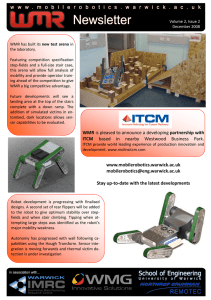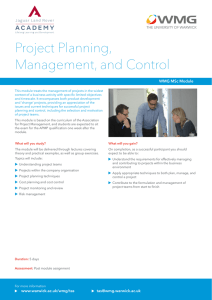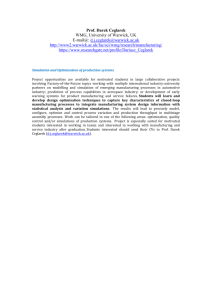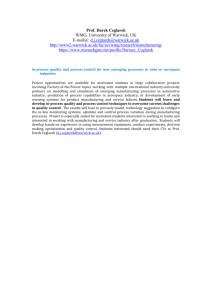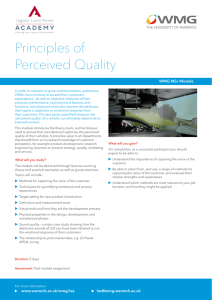Warwick Mobile Robotics: Urban Search and Rescue Robot
advertisement
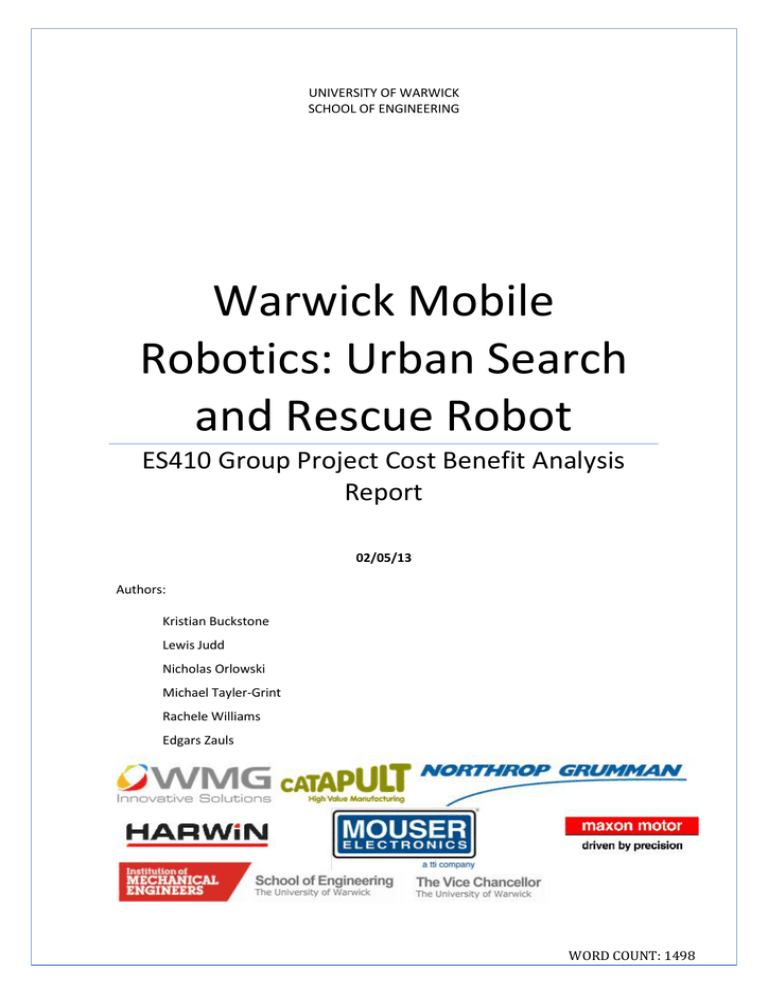
UNIVERSITY OF WARWICK SCHOOL OF ENGINEERING Warwick Mobile Robotics: Urban Search and Rescue Robot ES410 Group Project Cost Benefit Analysis Report 02/05/13 Authors: Kristian Buckstone Lewis Judd Nicholas Orlowski Michael Tayler-Grint Rachele Williams Edgars Zauls WORD COUNT: 1498 1 Introduction This Cost Benefit Analysis assesses the merits realised by the Warwick Mobile Robotics (WMR) project and provides justification for the time and costs incurred. WMR have developed their Urban Search and Rescue Robot (USARR); a machine intended to assist professional response teams with the recovery of victims in disaster zones by navigating areas deemed unsafe for humans. 2 Objectives The 2012/2013 aims: Participate in the World Robocup Rescue competition 2013 Make the USARR more viable for real world applications A SWOT analysis (Appendix A) highlighted three areas for improvement with objectives to achieve these: 1. Improve reliability: Unreliability, with functions failing on start-up, has been detrimental in past competitions. An unreliable system cannot be used in real-world disaster scenarios where lives are at risk. Reduce vibrations of head Increase the strength of the chassis to withstand 0.5m drops Eliminate recurring failures with electrical system Improved Reliability of the system Figure 1. Objectives to improve reliability 2 2. Improve operator control and awareness: Operator control is commercially important: intuitive control requires less training, resulting in quicker task execution with higher precision. Operator awareness allows more confident assessment of remote situations. Developing a better way to control the arm Developing a control interface that is more intiutive and easier to use Provide feedback to the operator from sensors, the flippers and the batteries Improved operator control & awareness Figure 2. Objectives to improve operator control 3. Progress towards real world readiness: In realistic situations, the robot must perform in unfavourable conditions. Testing can highlight areas for improvement and ensure the final design would meet a buyer’s requirements. Carry out a full system test in a real world scenario Taking measures to proof the robot against the elements Redesign the battery system to be easier to use Progress to real world readiness Figure 3. Objectives to progress real world readiness. Reassessment and reassigning of objectives resulted from the unanticipated loss of a team member. All objectives were met by tasks being allocated to individuals (Appendix B); these were logged and updated using a Gantt chart. 3 3 What work was undertaken, why and how? 3.1 Space Frame The new space frame is lighter and more robust (Figure 4) - the previous chassis had endured flipper bracket bending and excessive vibrations. Designs were tested physically (Inertial Measurement Unit attached to the flippers and driven from a 0.35m height (Figure 5)) and virtually (SolidWorks). Figure 4. Left: New Frame, Right: Old Chassis Figure 5. Time-lapse of high-speed footage 3.2 Shell A new shell has been manufactured (Figure 6) using ABS to protect inner components and also increase accessibility for maintenance through a removable lid. 4 Figure 6. New Shell Design on SolidWorks 3.3 Power Board A more compact power distribution board uses high-reliability (Harwin plc, 2013) connectors because the old power distribution board was unreliable and too large for the new chassis (Figure 7). 50W DC/DC converters with heat-sinks improve reliability / operating temperature range and small footprint power-FETs reduce board size. Figure 7. Top: New power board design. Bottom: Old design 5 3.4 Battery Monitoring A new battery management circuit protects against over/undervoltage, short-circuits and excessive discharge currents, with a fuel-gauge monitoring battery charge (Figure 8). Previously only an external alarm unit warned of a cell’s undervoltage. The new design uses two ICs – one for protection, one for fuel-gauging. Figure 8. Left: New battery monitoring circuit, Right: Old system 3.5 Battery Enclosure Batteries are now located higher up inside the front of the robot, allowing for safe traversing of rubble, with a new battery pack allowing easy insertion/removal. FEA on the ABS housing indicated 3mm optimal thicknesses. Guiding rails on the 3D printed part ensure accurate connector alignment. Figure 9. Above: New battery enclosure, Below: Previous battery enclosure 6 3.6 Sensors The CO2 sensor, gripper, LiDAR, webcams, IMU and infrared camera are now functioning (they were not before). The previously haphazard wiring has been systematically redone and a microcontroller now collects CO2 sensor data and provides PWM (Pulse Width Modulation) for the gripper. 3.7 Head Redesign A new head includes a removable lid to optimise maintenance access (Figure 10). ABS plastic (high impact resistance) was used to lightweight by 29% and to reduce vibrations. 3D printing was used customize compartments to fit each component. The removable sliding lid is less susceptible to dust and rain. Figure 10. Left: New head design, Right: Previous head design 3.8 Inverse Kinematics Inverse kinematics was implemented to make using the arm more intuitive. The two planes of motion (cylindrical and Cartesian co-ordinate frame) were modelled separately and the equations combined (Figure 11). r Figure 11. Arm in the Cartesian coordinate frame 7 3.9 GUI (Graphical User Interface) 3D representation has been included within an improved GUI to enhance driver awareness of surroundings. Figure 12. Above: New GUI design, Below: Old GUI design 8 3.10 Testing Partnership with Remotec (Northrop Grumman, 2013) allowed WMR to conduct structured outdoors testing at an industry facility for the first time ever. This was used to assess how well the team has achieved its aims and objectives. Figure 13. Mobile operator performing testing 9 4 Cost Benefit Analysis 4.1 Full Costing Project total cost was £54,821.59, comprising of material (competition travel included) and labour costs (hourly wage includes overheads). 4.1.1 Material Costs Material cost total was £8,765.59. Table 1 shows a breakdown of costs (full details in Appendix C). Table 1. Material costs by category 10 4.1.2 Labour Costs WMR have performed the majority of labour, technicians have completed manufacturing tasks and academic directors provided advice and support (Table 2). Table 2. Hours worked by person from Gantt chart 11 The Gantt chart associated with labour costs (Appendix D) is summarised in the Figure 14 flow diagram. Figure 14. Summarised Project timeline. Table 3 depicts allotment of labour to tasks. Table 3. Total hours worked by task. 12 4.1.3 Total Costs The total costs for WMR this year are shown in Table 4. Figure 15 visually depicts the breakdown of total costs. A Breakdown of Total Costing by Category Miscellaneous Chassis Competition Sponsorship & Publicity Power System Reports Sensors & Devices Control System Assembly & Testing Figure 15. Total costs by category. 4.1.4 Re-manufacture Costs For commercial release, the cost for complete re-manufacture (materials only) is £10,937.84 (Appendix E). 13 4.2 Benefits 4.2.1 Benefits to students Development of skills in Robotic engineering and specific degree disciplines can be applied to PhD research or specialist engineering jobs Development of time management, finance organisation and task allocation abilities Collaboration between degree disciplines has improved sub-system integration Commercial experience from working with an organisation’s administrative procedures and external sponsor organisations Improved reliability will allow WMR 2013/2014 to develop functionality without start-up delays, using lessons passed on from the World competition. 4.2.2 Benefits to academics Technology applied to renowned disasters will endorse engineering, robotics technology and Warwick University, especially through continued publicity Relationships with industry and sponsors can be maintained and developed New research themes can be identified and funded using past achievements Development of Robotics related teaching material Advancement in robotics knowledge to assist future disaster response solutions Expertise can be applied to commercial challenges, e.g. establishing a centre of expertise with Catapult to rival UK and International institutions. 4.2.3 Benefits to wider society Deployment of an USARR could reduce risks to professional disaster response teams, preventing further casualties. (Burke, 2003) This year’s design has progressed towards being able to be used in a disaster situation; in particular: Improved reliability, crucial for fast-paced emergency scenario Strengthened chassis allows for operation in more demanding environments 14 A more intuitive control system is valuable where operators may have minimal training More “off the shelf” parts for cheaper and easy re-build (Bishop, Crabbe, & Hudock, 2012). Cost reduction permits use of multiple robot teams to search greater areas, or back-up machines. 4.3 Outcomes and Achievements 4.3.1 Learning outcomes Alongside technical and management learning outcomes mentioned in section 5.2.1, the following lessons have been developed: 1. Dealing with unpredictability. Suppliers add uncertainty, so the team has learned to create back up plans to mitigate risks that could disrupt the project. 2. Coping with long lead times. Manufacturing processes can be lengthy and the team has learned to multi-task and reassess tasks whilst waiting on completion of jobs. 4.3.2 Sponsorship and Publicity As well as maintaining relationships with existing sponsors WMG (WMG, 2013), Harwin, Mouser Electronics (Mouser Electronics, 2013), Maxon Motor (Maxon motor ag, 2013), School of Engineering (Warwick School of Engineering, 2013) and the Vice Chancellor (Thrift), WMR has acquired three new sponsorship partners. WMG centre HVM Catapult has provided monetary assistance for lightweight materials, energy storage and management. 15 The Institution of Mechanical Engineers (Institution of Mechanical Engineers, 2013) has provided a Group project award to support travel to the World Robocup competition. Remotec, part of Northrop Grumman Corporation (Northrop Grumman, 2013), have formed a partnership with WMR to share technical expertise and provide testing facilities. Publicity activities have promoted WMR and engineering at Warwick University, such as attending the Coventry Imagineering Fair (The Imagineering Foundation, 2012) and articles published as local press releases and in professional engineering magazines. 4.3.3 Robocup World Competition 2013 WMR will be competing at the World competition, aiming to win Best in the World. As the only UK team to attend, this provides a unique opportunity to promote WMR, Warwick University and UK engineering. 5 Conclusion The key benefits include potential for commercialisation to assist in saving lives, knowledge and experience gained by students, academics and the wider society and increased publicity through competing in the World RoboCup competition. These are hard to quantify into monetary terms. When the total cost of £54,821.59 is considered, WMR feel the progress made from last year is high enough to justify these costs. 16 WORD COUNT: 1498 6 References Bishop, B. E., Crabbe, F. L., & Hudock, B. M. (2012). Design of a low-cost, highly mobile urban search and rescue robot. Advanced Robotics, 879-899. Burke, J. L. (2003). Moonlight in Miami: A Field Study of Human-Robot Interaction in the Context of an Urban Search and Rescue Disaster Response Training Exercise. University of South Florida. Harwin plc. (2013). Retrieved February http://www.harwin.com/aboutus/ 14, 2013, from About us: Institution of Mechanical Engineers. (2013). Retrieved April 9, 2013, from About the Institution: http://www.imeche.org/About-Us/about-the-institution Maxon motor ag. (2013). Retrieved February 14, 2013, from About Maxon Motor: http://www.maxonmotor.com/maxon/view/content/company mbed. (2013). mbed NXP LPC1768 Getting Started. Retrieved April 21, 2013, from https://mbed.org/handbook/mbed-NXP-LPC1768-Getting-Started Mouser Electronics. (2013). Retrieved http://uk.mouser.com/aboutus/ February 14, 2013, from About us: Northrop Grumman. (2013). Retrieved February 14, 2013, from Northrop Grumman in the UK: http://www.northropgrumman.com/uk/ The Imagineering Foundation. (2012). Fairs. Retrieved http://imagineering.org.uk/fairs/information/ April 2, 2013, from Thrift, N. (n.d.). Retrieved April 9, 2013, from Office of the Vice Chancellor and President: http://www2.warwick.ac.uk/services/vco/ Warwick School of Engineering. (2013). Retrieved February 14, 2013, from About the school: http://www2.warwick.ac.uk/fac/sci/eng/about/ WMG. (2013). Retrieved April 9, 2013, http://www2.warwick.ac.uk/fac/sci/wmg/about/ from About us: WMG centre HVM Catapult. (2013). About High Value Manufacturing Catapult. Retrieved February 14, 2013, from http://www2.warwick.ac.uk/fac/sci/wmg/research/hvmcatapult/about/ 17 7 Appendices 7.1 Appendix A – SWOT Analysis of the 2012 WMR rescue robot design Strengths Weaknesses Mobility: o Best in Class award received in 2012 German Open RoboCup Arm: o Strong and stable design, capable of manipulating the head to perform tasks at the competition Advanced sensors: o Investment already made o Enable scoring extra points in the competition Safety: o Emergency stop performs reliably Opportunities Difficult to control: o Arm can only be controlled in joint mode – slow and takes practise o Graphical User Interface (GUI) is poorly laid out and displays very little information o Shaky video feedback due to vibrations in arm and head o No feedback to the operator station from the batteries Poor reliability: o Front and rear cameras as well as the head servos sometimes fail to power up o IR camera and CO2 sensor wired up but non-functional o Difficult to access electronics for maintenance Safety: o Batteries difficult to connect and disconnect Threats Existing sensors and devices: o Hokuyo LiDAR and XSens inertial measurement unit can be used to attempt arena mapping or provide feedback to the operator o Existing gripper can be attached Software development: o GET-bot Collaboration o Inverse Kinematics Operator warnings: 18 Electronics: o Unpredictable failures at power-up of various sensors and devices o Undocumented wiring, lack of colour coding or labelling o Poorly done wiring and connectors Mechanical: o Damaged chassis parts (flipper brackets) o Damaged motors o Tip prevention o Battery monitoring system Readiness: o Testing in Remotec assault course o Increased ruggedness waterproofing, dustproofing Project Management: o Attract sponsorship due to higher profile competition o Learn from Remotec experience in designing bomb disposal robots 19 o Worn tracks Software: o Poorly documented code impeding software development 7.2 Appendix B – Reassignment of tasks following M. Truscott’s leaving On the 11/01/13 M. Truscott announced that he will be leaving the team with immediate effect. All tasks in the Gantt chart that were assigned to him at that point were either cancelled or reassigned (Table 5). Table 5. Reassignment of M. Truscott’s tasks. Task Status Comments UML Diagram and restructuring of the software architecture Cancelled This time consuming task will not be carried out. Instead local clean-up will be performed on an as-needed basis One click start-up Cancelled While an important feature for ease of use of the robot, this is not critical Fixing IR camera interface Reassigned Edgars Zauls Flipper and motor encoder feedback Reduced scope and High Priority as this is crucial for reassigned to Kris improved operator awareness. Feedback to GUI now only required from flipper Buckstone encoders. Implementing “heartbeat” Cancelled Implementing LIDAR interface Reassigned Edgars Zauls Implementing Xsens interface Reassigned to Kris Low Priority. Re-use of existing code permits yaw, pitch and roll information Buckstone to be integrated with robot 3D representation in the GUI Investigate appropriate SLAM techniques Cancelled Due to time constraints and the considerable complexity of the task Investigate LIDAR and IR based autonomy Cancelled Due to time constraints and complexity. This also lowers the workload for Nick developing head electronics to High Priority as this is crucial for scoring points in the competition While a useful feature, this is not critical. Implementation is likely to be difficult without restructuring the software first to Low Priority. This can be accomplished relatively easily by using existing code. Raw LIDAR data can then be displayed in the GUI as a driving aid 20 7.3 Appendix C – Total Material Costs Chassis Power System Sensors Devices 18mm Steel Bars Metal for body Bearings Bay Plastics HPC gears Acrylic for electronic brackets from Gilbert Curry Ind Plastics New Motor Angle Bracket Water jetting Grub screws TOTAL £380.11 £4.74 £85.66 £8.12 £1,265.98 Traco Power Supplies Power Boards I2C switch Mouser order Mouser order Mouser order TOTAL £220.05 £976.68 £2.03 £618.98 £30.39 £331.19 £2,179.32 CO2 board Flipper Encoders and Rapid Prototyping Panel mount USB cable TOTAL £13.00 £72.00 £19.20 £626.33 £19.82 £37.00 £10.00 £25.44 £576.98 £6.40 £618.82 Control System £0.00 Testing £0.00 Miscellaneous Board pens and duct tape T-shirts and stickers TOTAL Travel Budget Competition Entry Fees Transport Accommodation Food Expenses TOTAL £1,880.00 £950.00 £1,100.00 £570.00 £4,500.00 GRAND TOTAL £8,765.59 21 £3.97 £197.50 £201.47 7.5 Appendix D – Full Gantt Chart Notes: One day in the Gantt chart corresponds to 2 hours of working time. This is due to the fact that the project should account for 25% of student final year working time (and assuming 8 hour working day) Technician time included in the Gantt chart only accounts for consultations. Actual manufacturing time has been recorded by WMG workshop management in the job request system. 22 7.6 Appendix E – Cost for re-manufacture Component Cost (£) Part Number Supplier Chassis Metal for chassis space frame 72 Ravenace Metals Water Jetting for chassis space 80 frame AquaJet Electronics Flipper Encoders 25.13 Future Electronics CO2 Board 10 Custom design, in-house Power distribution board 400 Custom design, in-house Battery monitoring system 200 Custom design, in-house RX64 Servo, Robotics Dynamixel -PC interface Melexis sensor rotational USB2 441.65 Robotis position 41.48 MLX90316 Connectors Melexis Harwin Wire - Single Conductor 24AWG 134.05 (7 602-6712-100-xx Overclockers UK wires x (where xx depends 7/32 in various colours 19.15) on colour) AX3500 4 x 60A DC Motor 654.89 Controller AX3500 Active Robots Startech 4 Port USB To Serial 44.88 Adapter Hub - With COM Retention 161457 www.ebuyer.com Axis M1054 HD IP network 538 (£269 0338-003 camera x 2 x 2) www.networkwebcams.co.uk ASUS RT-N56U router 82.54 RT-N56U http://www.systo.co.uk/ Dynamixel Robotics RX-64 Servo 180.50 HN05-N101 http://robosavvy.com Flir Photon 160 Infrared Sensor 2,522.90 427 (historic part, Flir purchased in 2008) 23 HOKUYO Robotics Laser Range 1522.54 Finder URG-04LX Active Robots Intel DG45FC LGA775 Media 95 Series Mini-ITX Mainboard DG45FC http://linitx.com/ Mechanical 18mm silver steel bars 13 Ravenace Metals Bearings 19.20 SKF 38mm ID Carbon fibre tube (roll 110.97 wrapped) 0.5M for arm Easy Composites Double bossed Worm Gear HPC Gears Ltd Anti-backlash 160.21 1500 x 333mm Tool Steel Bar 5.89 Ravenace Metals 50 Tooth Anti backlash Worm 215.27 Gear Express HPC Gears 4mm Ball Bearings 8.95 QFT-671-1004D GTSS 2 x 940x50mm T10V Endless Belt 82.10 ZP40BS (historic Brammer UK Ltd part, purchased in 2008) 2 x 1100x75mm T10V Endless 125.64 Belt ZP40BS (historic Brammer UK Ltd part, purchased in 2008) Motor: RE50 (370354) Gearbox: 687.88 GP52C 4.3/1 (223081) Encoder: 110518 x 2 RE50 Maxon Motor Motor: RE35 (273754) Gearbox: 325.77 GP52C (223111) Encoder: 110514 RE35 Maxon Motor Motor: RE30 (310007) Gearbox: 697.95 GP32C 23/1 (166936X) Encoder: None x 3 RE30 Maxon Motor Motor: AMAX26 (11940) 193.50 Gearbox: GP32C 246/1 (166949) Encoder: None AMAX26 Maxon Motor Rapid Prototyping (head and 570 Dr Greg Gibbons from WMG, 24 battery cases) University of Warwick Shell x 2 made from ABS 630 Bay Plastics Ltd Lithium Polymer Batteries (x4) 180 (4 at £45 each) Various suppliers TOTAL: £10,937.84 25
